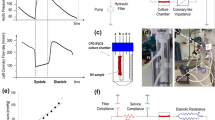Summary
Functional responses of canine circumflex coronary arteries and saphenous veins before and after grafting surgery were assessed following physiologic and pharmacologic intervensions. Developed tension of ringed segments of vessels was recorded isometrically. Dose-dependent responses to norepinephrine revealed significantly greater responses of saphenous veins than coronary arteries (maximal responses were 2.79±0.45 and 0.44±0.34 g, respectively; p<0.001). Sensitivity to norephinephrine [as evaluated by 50% effective dose (ED50) value] was 3.3 times greater in the saphenous veins (p<0.001). STA2, a synthetic thromboxane A2 analog (see Methods), produced similar contractions of both vessels [maximal responses were 2.13±0.37 g in saphenous vein and 1.64±0.85 g in coronary artery; p < not significant (NS)], while sensitivity to STA2 of saphenous veins was 3.1 times greater than that of coronary arteries (p<0.001). In contrast to the foregoing responses, coronary arteris demonstrated significantly greater responses to potassium than saphenus veins (maximal responses were 2.16±0.71 g and 1.40±0.56 g, respectively; p<0.001). Moreover, coronary arteries revealed 1.6 times greater sensitivity than saphenous veins (p<0.001). When saphenous veins were transplanted into the femoral artery, the segments of the grafts (2 weeks or 3 months after surgery) revealed 4.0 and 1.7 times greater sensitivity (denervation supersensitivity) to norepinephrine and potassium than those of the control veins (p<0.01, respectively). Contractile tension response, however, decreased by at least 50% 3 months after surgery, most probably due to a thickened vessel wall and a reduced compliance. Thus, the functional characteristics of the saphenous vein, which were totally different from those of the coronary artery, seemed to be preserved even after grafting except for denervation supersensitivity, which may modify the differences between the two vessels. Those differences may be relevant to the control of the coronary circulation after coronary bypass surgery.
Similar content being viewed by others
References
Victor MF, Kimbiris D, Iskandrian AS, et al. Spasm of a saphenous vein graft: A possible mechanism for occlusion of the venous graft. Chest 1981; 80:413–415.
Baduini G, Marra S, Angelino PF. Sudden occlusion of a saphenous vein coronary bypass graft relieved by direct injection of nitroglycerine. Cathet Cardiovasc Diagn 1981; 787–95.
Walinsky P. Angiographic documentation of spontaneous spasm of saphenous vein coronary bypass graft. Am Heart J 1982; 103:290–292.
Heijiman J, Gamal ME, Michaels R. Catheter induced spasm in aortocoronary vein grafts. Br Heart J 1983; 49:30–32.
Martin JL, Kusiak V, Untereker WJ. Ergonovine-induced spasm of a coronary artery bypass graft. Int J Cardiol 1983; 3:260–263.
D'Souza VJ, Velasquez G, Kahl FR, et al. Spasm of the aortocoronary venous graft. Radiology 1984; 151:83–84.
Zuberbuhler RC, Bohr DF. Responses of coronary smooth muscle to catecholamines. Circ Res 1965; 16:431–440.
Toda N. Isolated human coronary arteries in response to vasoconstrictor substances. Am J Physiol 1983; 245:H937-H941.
Shepherd JP, Vanhoutte PM. Veins and Their Control. Philadelphia: WB Saunders, 1975.
DeMey JG, Vanhoutte PM. Heterogenous behaviour of the canine arterial and venous wall. Importance of the endothelium. Circ Res 1982; 51:439–447.
Waddel WG, Vogelfanger IJ, Bosc M, et al. Changes in contractility, compliance and elasticity in experimental arterial vein-autografts. Cana J Surg 1973; 16:252–260.
Seidel CL, Lewis RM, Bowers R, et al. Adaptation of canine saphenous veins to grafting: Correlation of contractility and contractile protein content. Circ Res 1984; 55:102–109.
Brody WR, Kosek JC, Angell WW. Changes in vein grafts following aorto-coronary bypass induced by pressure and ischemia. J Thorac Cardiovasc Surg 1972; 64:847–854.
Spray TL, Roberts WC. Changes in saphenous veins used as aortocoronary bypass grafts. Am Heart J 1977; 94:500–516.
Fonkalssrud EW, Sanchez M, Zerubavel R. Morphological evaluation of canine autogenious vein grafts in the arterial circulation. Surgery 1978; 84:253–264.
Uchida Y. Decreasing potassium conductance—a possible mechanism of phasic coronary vasospasm. Jpn Circ J 1985; 49:128–139.
Wilson NH, Jones RL. Prostaglandin endoperoxide and thromboxane A2 analogs. Adv Prostaglandin Thromboxane Leukotriene Res 1985; 14:393–425.
Fleming WW, Westfall DP, De la Lande IS, et al. Lognormal distribution of equieffective doses of norepinephrine and acetylcholine in several tissues. J Pharmacol Exp Ther 1972; 181:339–345.
Gordon AR, Siegman MJ. Mechanical properties of smooth muscle, II. Active state. Am J Physiol 1971; 221:1250–1254.
Axelsson S, Bjorklund A, Flack B, et al. Glyoxic acid condensation: A new fluorescence method for the histochemical demonstration of biogenic monoamines. Acta Physiol Scand 1973; 87:57–62.
Trendelenburg U. Supersensitivity and subsensitivity to sympathomimetic amines. Pharmacol Rev 1963; 15:225–276.
Fleming WW, Mcphillips JJ, Westfall DP. Postjunctional supersensitivity and subsensitivity of excitable tissues to drugs. Ergeb Physiol Biol Chem Exp Pharmakol 1973; 68:56–119.
Westfall DP. Supersensitivity of smooth muscle. In: Buelbring E, Bradind AF, Jones AW, Tomita T, eds. Smooth Muscle: An Assessment of Current Knowledge. London: Edward Arnold, 1981; 285–309.
Urquilla PR, Fleming WW. Nonspecific supersensitivity induced by elevated extracellular potassium concentration ([K+]). Pharmacologist 1974; 16:273.
Fleming WW, Westfall DP. Altered resting membrane potential in the supersensitive vas deferens of the guinea-pig. J Pharmacol Exp Ther 1975; 192:381–389.
Wesly RLR, Vanishnav RN, Fuchs JC, et al. Statistic linear and nonlinear elastic properties of normal and arterialized venous tissue in dog and man. Circ Res 1975; 37:509–520.
Buda AJ, Fowles RE, Schroeder JS, et al. Coronary artery spasm in the denervated transplanted human heart. Am J Med 1981; 70:1144–1149.
Author information
Authors and Affiliations
Rights and permissions
About this article
Cite this article
Isshiki, T., Akatsuka, N., Saito, T. et al. Comparison of functional responses of canine coronary artery and saphenous vein. Cardiovasc Drug Ther 2, 325–331 (1988). https://doi.org/10.1007/BF00054639
Issue Date:
DOI: https://doi.org/10.1007/BF00054639




